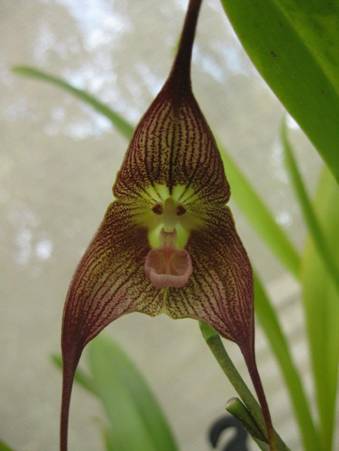
Salty Sam’s Fun Blog for Children
Number 280
Growing Orchids
Hello Everyone

Do you have an orchid in your house?
There are over 15 million orchids sold a year in Britain so the chances are you may have one.
And 75% of them are moth orchids which are very easy to look after.
They quite like sitting on bathroom window sills.
But there is a huge variety of shapes and colours to choose from if you want to start keeping them.
Moth orchids are the easiest to keep. They don’t need a big pot. ln fact, a lot of orchids quite like to be pot-bound. Use rainwater if you can, and don’t over water them. They must be grown in special orchid compost.
There are about 30,000 species of orchids – which makes them the largest flower family in the world.
ln the wild, they are found in all habitats where plants flourish: in grass, in the woods and even up in trees.
You may have seen them growing wild in the grass when you have been for a walk. Some of them are very rare and so are protected by law.
The orchids that grow in the rainforest can often survive with very little room for their roots, maybe in just a crack in a tree’s bark. British orchids often grow in grassland. Some of them are very fussy about their surroundings, only growing on chalk grassland, for example.
Some of these orchids have fascinating shapes. The bee orchid looks like a bee, the man orchid has flowers that look like little men and the monkey orchid has flowers that look like little monkeys with tails.
The lizard orchid has flowers with tiny streamers coming from them; they look like the back end of a lizard with a long tail disappearing into the flower.
The greater butterfly orchid only smells in the evening because it is pollinated by moths that are around in the evening.
lf you have a moth orchid as a house plant, you will see a little landing pad at the front for pollinating insects to land on. This is called a lip.
Every flower has a particular shape which has evolved on a particular way to live a successful life.
lf flowers have long tubes at the back, it is possible that in their natural habitat they are pollinated by humming birds which have long, curved beaks or even moths or butterflies which have very long tongues. Bees just can’t manage to reach the nectar at the bottom of these flowers.
One large orchid called Bulbophyllum picturatum smells like rotten fish in order to attract flies and other similar insects to pollinate it.
Moth orchids can last from 3 days to 20 years and other types can last from 2 years to 100 years!
Some types that are very rare can be extremely expensive to buy.
Bye bye everyone – don’t forget to subscribe to my blog!
lf you like my blog, please support it by telling all your friends and followers about it.
Thank you!
And see you again next Fun Friday!
Love and kisses
Salty Sam

www.christina-sinclair.com


Bill and Bob’s Joke of the Week![]()
![]()
Bob: Did you hear that Auntie Alice mixed up some grass seed with some budgie seed?
Bill: No?
Bob: And now she has to mow her budgie twice a week!

Salty Sam © Christina Sinclair 2015
Unauthorized use and/or duplication of material from this blog without express and written permission from this blog’s author and owner is strictly prohibited.
Links may be used to www.christina-sinclair.com

Picture Gallery
 Bulbophyllum
Bulbophyllum
 Moth orchid
Moth orchid
 Aquilegia
Aquilegia
(Quazoo.com)
 A man orchid
A man orchid
 This looks like a monkey body
This looks like a monkey body
 This looks like a monkey face
This looks like a monkey face


 THE SALTY SAM NEWS DESK
THE SALTY SAM NEWS DESK

I really enjoyed having the children staying with me here in the lighthouse. We spent a lot of time sitting around the stove in the evenings telling each other stories. I think Bill and Bob made some of theirs up – but of course mine are all true; well, mostly anyway.
Bill and Bob told me one story about the time their parents had to work late one night and so one of the neighbours, Melissa, came in to look after them when they came home from school.
She is a teenager trying to earn some extra money by starting up a baby-sitting service in Rocky Bay.
Sorry – Bill and Bob prefer to call it child-sitting because they say that they are not babies anymore.
After they had finished their homework, they felt bored, so Melissa told them about how she had made the light switch in her bedroom into a funny face.
She used the switch in the centre of the plate as a nose and stuck eyes and a mouth around it to make it into a face.

Bill and Bob wanted to make their bedroom light switch into a face as well, so Melissa showed them how to do it.
Then she went to watch the television and didn’t notice that Bill and Bob carried on making funny faces out of all the light switches in the house!
Their parents didn’t come home from work until after Bill and Bob had gone to bed. They were so tired that they didn’t even notice the new artwork in their house.

Don’t you do this at home yourself without permission!!!

*********************
TO ADVERTISE ON THIS BLOG
PLEASE CONTACT:
christina.sinclair.ads@aol.co.uk
*********************


Quick Quiz
Can you un-jumble these funny words to find types of flowers?
- ragomild
- lutip
- sidya
- locrev
- naiddeon
- vooxfleg
- faddfoil




lt’s the Weekend!

HOW TO MAKE A JEWELLERY GlFT BOX
If you would like to give someone jewellery as a gift but you have nothing nice to put it in, this little box would be ideal.
You could even make them some jewellery as well – like a bracelet or necklace or pair of earrings.
You could leave the inner skin of canvas un-worked and put a square of felt in the bottom – this would be useful for hooking earrings into. Or even a piece of patterned paper.

In the photograph, the inner skin of the box is covered in cross stitch. The crosses are worked in different directions in chequer board fashion to create an interesting texture.
If you think this would be too difficult for you to do, just keep the crosses worked in the same direction.
Or use the same tent stitch which is used on the outside of the box to make it even easier.
You will need just one sheet of plastic canvas and some dk yarn in a choice of four colours.



You will need 1 sheet of 7 mesh 10.5 by 13.5 inches/26.7 by 34.3cm
BRACELET/NECKLACE GIFT BOX
Cut the following panels:-
Outer lid top 23 x 23 holes 1 piece
Outer lid sides 23 x 5 holes 4 pieces
Work 5 coloured stripes of two rows of tent stitch but leave a row of holes at each end of the stripes – in the photograph there are three stripes of air force blue and two of baby blue
Fill in the rest of the panel with tent stitches in black yarn
The side panels are covered in tent stitch worked in black yarn
Inner lid top 21 x 21 holes 1 piece
Inner lid sides 21 x 4 holes 4 pieces
Cover these with crosses worked in white yarn
Outer base bottom 21 x 21 holes 1 piece
Outer base sides 21 x 7 holes 4 pieces
Leaving a row of 4 holes around the outside, work crosses of alternate light and dark blue yarn to make a centre panel of chequer board crosses – you can work them in the same direction or different directions
Then fill in the border with tent stitch worked in black yarn
TIP
If you have a habit of making your crosses in the same direction and find it difficult to change, then just tip the canvas to the side and work in your usual way.
Inner base bottom 19 x 19 holes 1 piece
Inner base sides 19 x 6 holes 4 pieces
Cover these with crosses worked in white yarn



TO MAKE UP
- Sew the sides of the outer lid to the outer lid top with black yarn, then sew up the corners with black yarn
- Sew the sides of the outer base to the bottom of the outer base with the darker blue yarn, then sew up the corners
- Only sew the sides of the inner panels to the larger square of the inner panel using white yarn (don’t sew up the corners – just over-sew along them so that the ends of the panels are covered with stitches otherwise the plastic will be left bare)
- Sew the inner lid to the outer lid with light blue yarn along the rim – sew just into the outer skin for just 1 hole at each end because you have 2 more holes on the outer panel than the inner
- Sew the inner base to the outer base using light blue yarn along the rim – sew just into the outer skin for just 1 hole at each end because you have 2 more holes on the outer panel than the inner
Look at the photograph to see the pattern of stitches.
To make a bead bracelet or necklace, just thread beads onto a length of very strong thread or shirring elastic, tie a strong knot and slip the knot into a bead.
Make sure that you will be able to slip a bracelet over a hand or a necklace over a head – otherwise you will not be able to get it on!
TIP
Thread beads onto elastic while it is still attached to the spool – then the beads will be easier to keep under control.

Please note that the material on this blog is for personal use and for use in classrooms only.
It is a copyright infringement and, therefore, illegal under international law to sell items made with these patterns.
Use of the toys and projects is at your own risk.
©Christina Sinclair Designs 2015


Quick Quiz Answers
- Marigold – ragomild
- Tulip – lutip
- Daisy – sidya
- Clover – locrev
- Dandelion – naiddeon
- Foxglove – vooxfleg
- Daffodil – faddfoil




This is the most fantastic way for children to learn.
l always appreciate readers taking the time to write in with comments. Thank you very much!